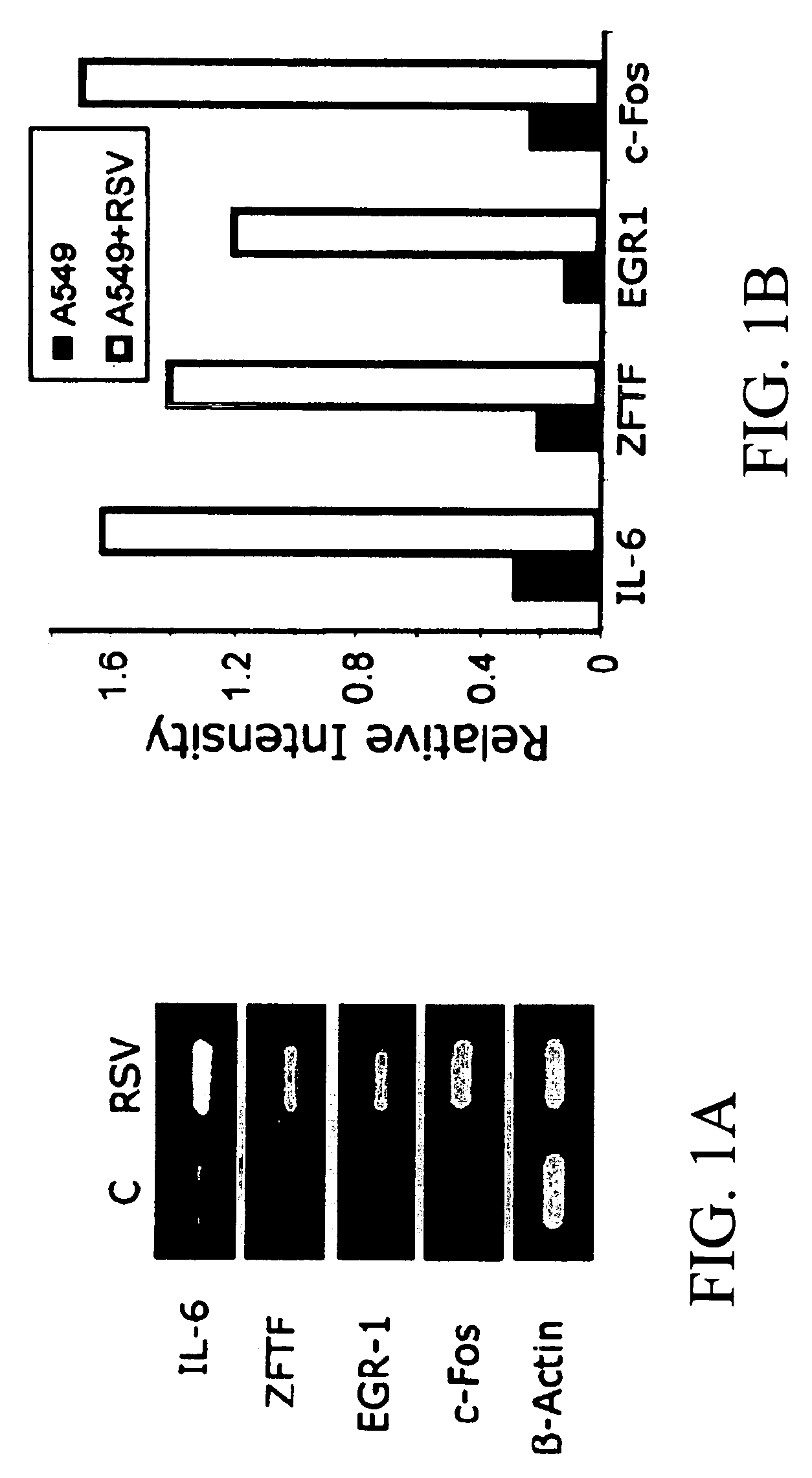JAK/STAT inhibitors and MAPK/ERK inhibitors for RSV infection
a technology of rsv infection and mapk, which is applied in the direction of dna/rna fragmentation, drug compositions, peptides, etc., can solve the problems of unknowable whether rsv infection may activate stat-1, untreated rsv infection, and untreated rsv infection, so as to reduce the likelihood of developing , to treat or reduce the likelihood of developing
- Summary
- Abstract
- Description
- Claims
- Application Information
AI Technical Summary
Problems solved by technology
Method used
Image
Examples
example 1
RSV-Induced Early Gene Expression Analysis Suggests Involvement of STATs
[0187]In an effort to identify and characterize the molecules participating in early signaling pathways, differential gene expression in supRSV-infected A549 cells was performed. Analysis of RNAs from uninfected control and supRSV-infected A549 cells revealed altered expression of 53 genes. Expression ranged from a 5.5-fold reduction to a 56.4-fold increase and genes showing >3-fold changes in expression in RSV-infected cells are listed in Table 1. Expression of five genes was downregulated 2.2-5.5-fold in cells infected with RSV compared to the control (data not shown). Four regulatory genes, early growth response (EGR-1), c-Fos, zinc-finger transcription factor (ZFTF), and interleukin-6 (IL-6), were upregulated 2-10-fold as measured by RT-PCR (FIGS. 1A and 1B). These genes were selected based on their high expression as well as their potential role in viral pathogenesis. Northern blot analysis of control and R...
example 2
RSV Exposure Induces STAT-1α in A549 and NHBE Cells
[0189]RSV infection induced the phosphorylation of STAT-1α in A549 cells with maximum phosphorylation at 30 minutes and a decrease 1-2 hours after RSV infection (FIG. 2A). To determine if STAT phosphorylation was specific to A549 cells, primary cultures of NHBE cells were exposed to RSV for 30 minutes. NHBE cells also activated STAT-1α in response to RSV (FIG. 2A). Factors are present in the viral supernatant that might affect STAT-1α phosphorylation; therefore, RSV was purified by sucrose gradient centrifugation to remove these factors. Exposure of A549 cells to purified RSV (purRSV) also induced STAT-1α phosphorylation (FIG. 2A). To verify that phosphorylation activated STAT-1, the nuclear localization of phospho-STAT-1 was examined by immunofluorescence. A549 and NHBE cells were exposed to supRSV or purRSV at an MOI of 1 for 30 minutes and stained with antibody to phospho-STAT-1α Both supRSV and purRSV induced nuclear localizatio...
example 3
RSV Attachment is Critical to STAT Activation
[0190]RSV suspensions were incubated with antibodies to the RSV F or G protein (CHEMICON, Temecula, Calif.) and immunoprecipitated with protein A-Sepharose to deplete them of RSV. RSV depletion blocked STAT-1α activation, as shown in FIG. 3A, indicating that interaction of epithelial cells with RSV is required for STAT-1α phosphorylation. RSV infection involves attachment of G proteins to cellular peptidoglycans, such as heparan sulfate, and fusion with the cell membrane via the viral F protein. Treatment of cells with heparin or heparinase blocks RSV infection (Feldman, S. A. et al. J. Virol., 1999, 73(8): 6610-6617). RSV-induced activation of STAT-1 was abolished in A549 cells treated with heparin or heparinase or infected with RSV that had been pretreated with heparin or heparinase, as shown in FIG. 3B. These experiments indicate that RSV attachment is required for STAT-1α activation.
PUM
| Property | Measurement | Unit |
|---|---|---|
| particle size | aaaaa | aaaaa |
| electrophoretic mobility shift assay | aaaaa | aaaaa |
| fluorescent images | aaaaa | aaaaa |
Abstract
Description
Claims
Application Information
 Login to View More
Login to View More - R&D
- Intellectual Property
- Life Sciences
- Materials
- Tech Scout
- Unparalleled Data Quality
- Higher Quality Content
- 60% Fewer Hallucinations
Browse by: Latest US Patents, China's latest patents, Technical Efficacy Thesaurus, Application Domain, Technology Topic, Popular Technical Reports.
© 2025 PatSnap. All rights reserved.Legal|Privacy policy|Modern Slavery Act Transparency Statement|Sitemap|About US| Contact US: help@patsnap.com



